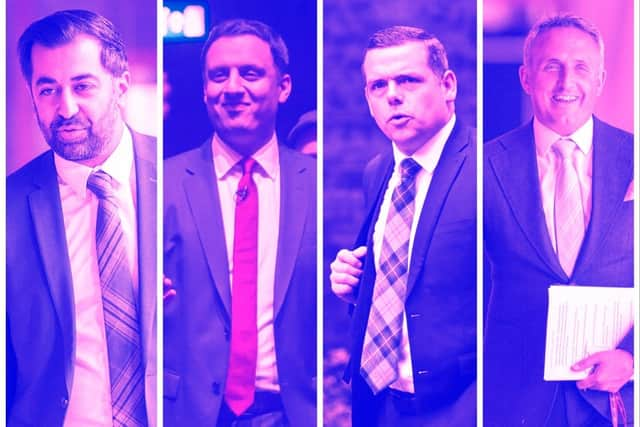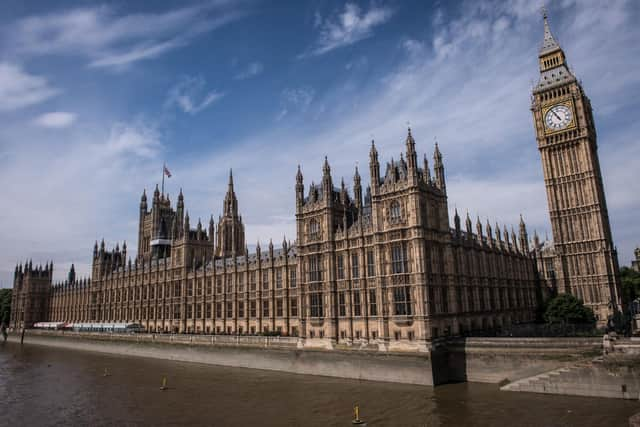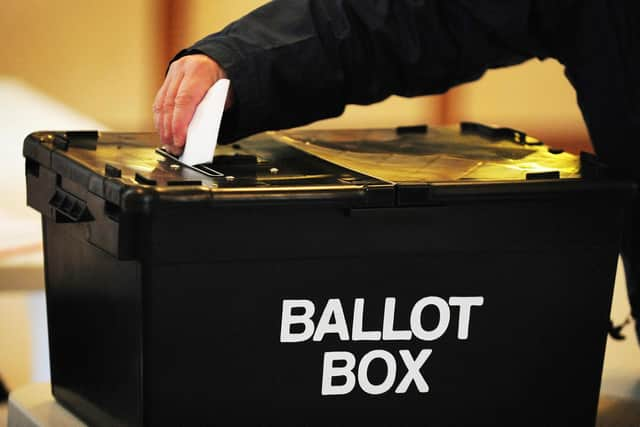Battleground Scotland: The key seats and battlegrounds at the general election
The UK will go to the polls later this year, with an election widely expected to take place in either October or November.
For Labour, the national picture is incredibly promising, with polling expert Professor John Curtice saying there is a “99 per cent” probability they form the next Government.
Advertisement
Hide AdAdvertisement
Hide AdThis follows consistently strong polling for Labour, with YouGov this week placing Labour on 40 per cent, with the Tories languishing on just 21 per cent.


However, in Scotland the forecast is less clear. Everyone expects Labour to improve, with Redfield and Wilton polling last month placing the party on 34 per cent, one point ahead of the SNP.
While the SNP are still confident of being the biggest party in Scotland, support has dropped dramatically, falling well below the support polled for independence.
Elsewhere the Scottish Lib Dems and Scottish Tories are hopeful of maintaining seats, and even adding to their totals, with the latter defying the national polling.
The Periodic Review of Westminster constituencies last year has also put the cat among the pigeons, with boundary changes bringing in opposition voters in a host of seats.


With that said, here are the target seats for the main parties, and where they think the general election in Scotland will be won or lost.
SNP
Speaking to SNP MPs, the word that frequently comes up is “challenge”, following Nicola Sturgeon’s resignation and a series of scandals.
For so long the third biggest party in Westminster, and with a dominance in Scotland, MPs are now privately admitting some of their colleagues will hold their seats.


Advertisement
Hide AdAdvertisement
Hide AdMaintaining their current 43 MPs seems very unlikely, but the party still has a raft of target seats, which party strategists hope can keep them Scotland’s dominant party.
The most notable of these is Moray West, Nairn and Strathspey, a seat changed by the boundary review, but in its current form is held by the Scottish Tory leader, Douglas Ross.
Now standing down to focus on Holyrood, SNP candidate Graeme Leadbitters is the favourite. Elected to Moray Council in 2007, he worked for Angus Robertson when he held the seat.
They are also targeting Caithness, Sutherland and Easter Ross, a seat held by Lib Dem MP Jamie Stone since 2017, he retained it in 2019 with a majority of just 204. With boundary changes, the party is now hopeful Lucy Beattie can win it.
The SNP believe both seats are for the taking, with the redrawn boundaries encompassing areas more supportive to the SNP.
They are also confident of their candidate Grant Costello winning East Kilbride, Strathaven and Lesmahagow, which was an SNP seat until Dr Lisa Cameron defected from the Tories.
Slightly longer shots for the party are Aberdeenshire West and Kincardine, as well as Dumfries and Galloway, both of which have previously been SNP seats. The former is held by Nuclear and Networks minister Andrew Bowie, while the latter is occupied by the Scotland Secretary Alister Jack, who is standing down.
Dumfries and Galloway will be contested by Tracey Little for the SNP, and John Cooper for the Scottish Tories, a former journalist who now works as a special advisor to Mr Jack.
Labour
Advertisement
Hide AdAdvertisement
Hide AdLabour’s approach is not to focus on Tory-held seats, other than perhaps Ms Cameron's, because it does not expect to win them.
The party plans to dedicate significant funding to seats in Glasgow, chunks of Lanarkshire, several towns in Scotland's central belt, parts of the east coast around Edinburgh, the Western Isles and perhaps even more. There is a growing hope they could exceed their own ever-growing targets.
Party figures believe the SNP is worried about losing half of its seats, following disastrous polling, and growing discontent on the doorstep.
Target seats are understood to include East Renfrewshire, where Blair McDougall, who ran the indyref campaign, is the candidate. In the seats around Ayrshire, party polling is also very strong.
The hope is that the party can dominate in the central belt, and, on a good day, expand into the south west and north east of Scotland.
Looking at the numbers, if both the Lib Dems and Tories hold their four and six seats, there will be just 47 left. Labour thinks 28 of Scotland's 57 seats are in play, and winning 24 of them is not considered “unrealistic”.
Electoral calculus analysis predicts Scottish Labour will take the majority of seats, including that of Midlothian MP and SNP Chief Whip Owen Thompson, as well as the seats of Deirdre Brock, Ronnie Cowan, Kenny MacAskill, Marion Fellows and David Linden.
Conservatives
Mr Ross’s party currently hold six seats, and following boundary changes are hoping that hoping that they can defy the wider expected UK collapse, and add seats.
Advertisement
Hide AdAdvertisement
Hide AdWhen it comes to defending, there is hope that while Mr Bowie holds a slim majority in Aberdeenshire West and Kincardine, swings in Scotland and voters coalescing around the Scottish Tories could given them a strong chance.
Former Scotland Secretary David Mundell is also expected to win in Dumfriesshire, Clydesdale and Tweeddale.
Moray West will now take in more of SNP MP Drew Hendry’s seat, which is expected to be an SNP hold.
There is also optimism around Harriet Cross in Gordon & Buchan, a new seat where she will face Richard Thomson, the SNP Wales and Northern Ireland spokesperson.
Another target is SNP MPs Brendan O’Hara’s revised seat of Argyll, Bute and South Lochaber, where a Tory source suggested swing voters could help them win.
Seats previously held are also goals, including Kirsten Oswald’s East Renfrewshire seat, once held by Tory Paul Masterton. Luke Graham, former Tory MP for Ochil and South Perthshire and head of the Downing Street union unit is running in Perth & Kinross-shire, while MSP Stephen Kerr is hoping to win in Angus & Perthshire Glens.
In total, the party has 12 targets, and hopes for success by focusing on Humza Yousaf’s record on taxation, as well as independence.
A Tory source said: “There will be a very strong effort. In certain seats, it will come down to just handful or a few 100 majority.
Advertisement
Hide AdAdvertisement
Hide Ad“Paradoxically, Labour leading the opinion polls helps them to vote for us, if they think the Tories are going to kick them out of office anyway.
“They’d rather not have an SNP held seat anyway and can vote for us if they’ve got the security blanket of knowing the Tories are not forming the next government.
"We will try to keep focus on Humza and the SNP’s record, with less time speaking about UK Government and UK issues. He is vulnerable having put independence page one line one.
"I think the SNP vote will fall away further. On the day, some of their supporters, who still want independence, probably aren’t going to show up. I think they are really going to have real difficulty”.
Liberal Democrats
For the Lib Dems, the focus is on maintaining the seats that they have, with the aim of possibly adding one or two.
A party source told Scotland on Sunday that the “SNP were in some difficulty”, and the party were still “reasonably confident” they would be able to do enough to hold their four seats.
The top target is Mid Dunbartonshire, formerly East Dunbartonshire, which was won by Amy Callaghan in 2019, unseating the-then Lib Dem leader, Jo Swinson.
Inverness, Skye and West Ross-shire is another target, which is held by the SNP economy spokesperson Drew Hendry.
Advertisement
Hide AdAdvertisement
Hide AdHowever, there is a feeling it’s not about just making gains, but about putting the party back in contention for the election after by coming second in more seats.
A source said: “If the election was tomorrow then the worst result is we hold the four we have, but we should be able to make that five or possibly six. What is interesting is the fact that in the SNP Tory seats, it’s much more difficult to guess. A lot of Lib Dems in the North East might have held their nose and voted Tory because of the constitutional question. If they no longer see the SNP being the threat that it was, and the Tories are the shambles we know they are, it’s much less likely they’ll hold their nose again.
“It looks like we’ll have a much more significant presence than last time. You’ve got to look at where you next round of gains or progress comes through”.
Comments
Want to join the conversation? Please or to comment on this article.
